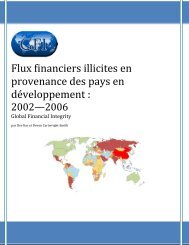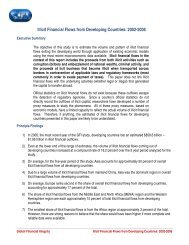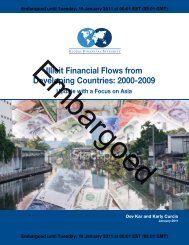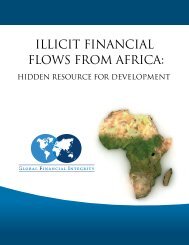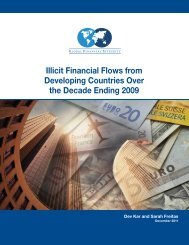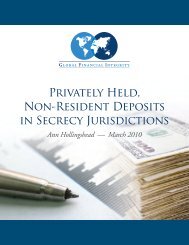Illicit Financial Flows
Illicit Financial Flows and the Problem of Net Resource Transfers ...
Illicit Financial Flows and the Problem of Net Resource Transfers ...
Create successful ePaper yourself
Turn your PDF publications into a flip-book with our unique Google optimized e-Paper software.
STRICTLY EMBARGOED UNTIL TUESDAY NIGHT, 28 MAY 2013<br />
AT 18:59 EDT / 23:59 BST / 23:59 WEST / 23:59 CET<br />
As the 2007 Balance of Payments Statistics Yearbook notes: 12<br />
Under the conventions of the system, a compiling economy records credit entries (i) for real<br />
resources denoting exports and (ii) for financial items reflecting reductions in an economy’s<br />
foreign assets or increases in an economy’s foreign liabilities. Conversely, a compiling<br />
economy records debit entries (i) for real resources denoting imports and (ii) for financial<br />
items reflecting increases in foreign assets or decreases in foreign liabilities. In other words,<br />
for assets—whether real or financial—a positive figure (credit) represents a decrease in<br />
holdings, and a negative figure (debit) represents an increase. In contrast, for liabilities, a<br />
positive figure shows an increase, and a negative figure shows a decrease. Transfers are<br />
shown as credits when the entries to which they provide the offsets are debits and as debits<br />
when those entries are credits.<br />
Transactions are also of different types and the balance of payments must make room for recording<br />
them in a manner that is consistent across countries. That is a major raison d’être of the BPM6 and<br />
its predecessors—to ensure a framework of recoding different types of international transactions on a<br />
consistent basis across countries so that BOP statistics are meaningful for policymakers and researchers.<br />
Transactions can be either exchanges or transfers, monetary or non-monetary. As the BPM6 notes:<br />
An exchange involves a provision of something of economic value in return for a counterpart<br />
item of economic value. Purchases of goods and services, acquisition of assets,<br />
compensation of employees, dividends, etc., are all exchanges. An exchange is sometimes<br />
called a transaction with “something for something” or a transaction with a quid pro quo. A<br />
transfer involves a provision (or receipt) of an economic value by one party without receiving<br />
(or providing) a counterpart item of economic value. Taxes, debt forgiveness, grants, personal<br />
remittances are examples of transfers. A transfer is also called a transaction with “something<br />
for nothing” or a transaction without a quid pro quo.<br />
The estimation of NRecT involves all four kinds of external transactions (i.e., exchanges and<br />
transfers - either monetary or non-monetary) which are recorded in the various accounts of<br />
the balance of payments. The inclusion of transfers involving non-financial assets results in the<br />
terminology “Net Recorded Transfers” and not “Net Capital Transfers”. It is important to keep in<br />
mind that the reference to transfers here also includes exchanges.<br />
The balance of payments also accounts for certain non-financial, non-produced assets such as<br />
debt write-offs or write-downs. While these flows are not included in the financial account, they<br />
nevertheless involve a transfer of resources from the creditor to the debtor country. As noted earlier,<br />
every transaction can be either monetary or non-monetary in character. In the case of monetary<br />
transactions, one party makes a payment or receives a payment or incurs a liability or acquires an<br />
12<br />
Reference, 2007 Balance of Payments Statistics Yearbook, Annex V, page xxi, International Monetary Fund.<br />
<strong>Illicit</strong> <strong>Financial</strong> <strong>Flows</strong> and the Problem of Net Resource Transfers from Africa: 1980-2009<br />
59



